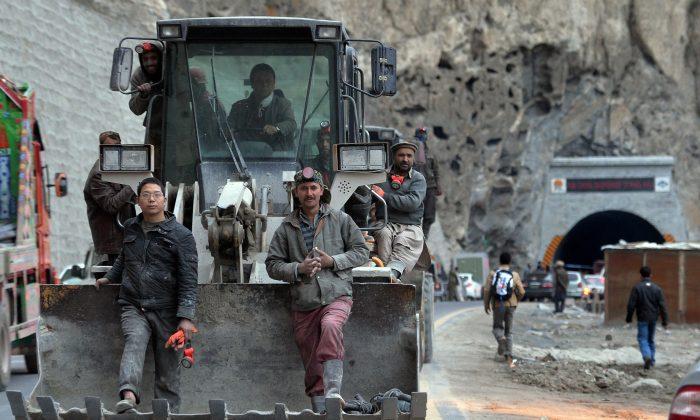China’s “One Belt, One Road” initiative seeks to makes infrastructure investments in more than 60 countries across Asia, Africa, and Eastern Europe. But it also could burden China’s already capital-constrained banks with even more risky assets, increasing default rates and further destabilizing the country’s financial system.
The program lends to developing countries to finance roads, bridges, and other infrastructure projects as part of Beijing’s broader efforts to expand trade and influence.
While policy banks such as the Asian Infrastructure Investment Bank (AIIB) have pledged support, a large portion of financing expects to come from China’s major commercial banks.
Source of Demand
The project has been described as China’s version of the “Marshall Plan.” It aims to do more than just upgrade the infrastructure of developing countries. The initiative was created partly to cultivate new markets to buy up China’s large excess capacity in the steel, coal, and container shipping industries.
Beijing for years has looked to cut dependency on heavy industries. But it cannot do so without simultaneous lowering economic growth rates and creating potential social instability in its poorer inland and Northeastern provinces whose economies depend on coal and steel production.
Projects sponsored by One Belt, One Road provide a vehicle to sell such surplus coal and steel to developing countries, and increase utilization of maritime shipping.
Repayment Question
According to estimates from Fitch Ratings, total overseas loans—including One Belt, One Road—extended by Chinese banks during the first half of 2016 totaled $1.2 trillion, with commercial banks providing two-thirds of the funding.
“The lack of commercial imperatives behind OBOR (One Belt, One Road) projects means that it is highly uncertain whether future project returns will be sufficient to fully cover repayments to Chinese creditors,” a Jan. 26 Fitch report warned. In other words, the ratings agency is skeptical as to whether the loans would be repaid as agreed. Fitch assigns “junk” ratings to several markets China invests in, but a few nations, such as Laos, have no rating at all and are highly risky.
The entire project is more of a political gamble than a calculated commercial venture. It would be less a concern if One Belt, One Road was primarily funded by infrastructure or policy banks, or the Chinese government directly. The issue lies in that most of the funding for the initiative was provided by commercial banks. These banks hold most of the cash savings of ordinary Chinese consumers, are publicly listed, and their stocks are widely held by retail investors.
“Banks do not have a track record of allocating resources efficiently at home, especially in relation to infrastructure projects—and they are unlikely to have more success overseas,” Fitch said.
Systemic Risks
One Belt, One Road hardly represents the first instance that commercial banks have been forced to put political interests ahead of profitable commercial activity.
While the structure of most loans is not public, it is believed that the loans have variable seniority, with the most senior (least risky) tranches going to the commercial banks. But if returns are subpar, the initiative could put further strain on an already taxed banking system.
Chinese domestic infrastructure loans already make up a disproportionately large part of total non-performing loans (NPL) within the banking sector.
Officially, China’s NPL ratio—the ratio of NPLs to total loans outstanding—was 1.81 percent during the fourth quarter 2016, a bit higher than the 1.76 percent reported at the third quarter, according to the China Banking Regulatory Commission.
But independent estimates peg the actual rate of NPLs at much higher. Third-party estimates from CLSA and other banks state China’s NPL rates to be as high as 15 to 20 percent.
Beside the rate of bad loans, the speed of growth in total debt has been dizzying. Debt in the non-financial sector grew almost 75 percent since 2011, compared to the 8.6 percent in debt growth during the same period leading up to the 2008 financial crisis.
Additional loans from the One Belt, One Road initiative will likely only exacerbate China’s growing NPL problem, and could lead to a banking system crisis.
And the crisis wouldn’t just be confined to the Chinese banking system. From the perspective of borrowers, failure to repay the loans could trigger crises for the governments and regional economies of the countries receiving the investment.
Some countries, such as Laos, provided guarantees or asset collateral to backstop their One Belt, One Road loans, which could raise lending recovery rates in the event of repayment difficulty. For example, Kyrgyzstan’s debt from China’s Export Import Bank was almost 20 percent of its GDP in 2015.
Whether the ambitious One Belt, One Road project can succeed will have huge ramifications within the Chinese banking system, and impact the economic well-being of several regions.





